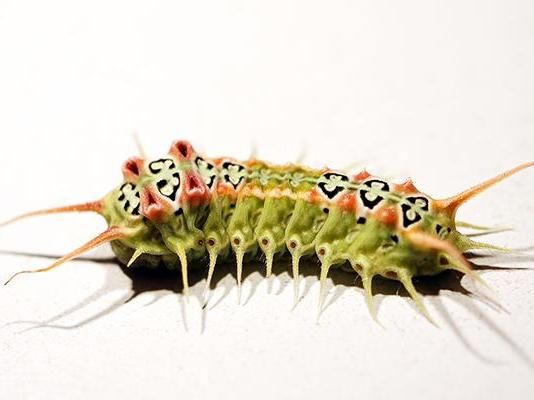Very venomous caterpillar has strange biology
Potential for medicines and pesticides
The venom of a caterpillar, native to South East Queensland, shows promise for use in medicines and pest control, Institute for Molecular Bioscience researchers say.

The Doratifera vulnerans is common to large parts of Queensland's south-east.
Jiayi Jin
The Doratifera vulnerans is common to large parts of Queensland's south-east and is routinely found in Toohey Forest Park on Brisbane's southside. Dr Andrew Walker has been researching the striking looking caterpillar since 2017. "We found one while collecting assassin bugs near Toowoomba and its strange biology and pain-causing venom fascinated me," Dr Walker said.
Unlike The Very Hungry Caterpillar that charmed generations of children around the world, this caterpillar is far from harmless. "Its binomial name means 'bearer of gifts of wounds'," Dr Walker said.
Dr Walker's research found the caterpillar has venom toxins with a molecular structure similar to those produced by spiders, wasps, bees and ants. The research also unlocked a source of bioactive peptides that may have uses in medicine, biotechnology or as scientific tools.
"Many caterpillars produce pain-inducing venoms and have evolved biological defences such as irritative hairs, toxins that render them poisonous to eat, spots that mimic snake eyes or spines that inject liquid venoms," Dr Walker said. "Previously researchers had no idea what was in the venom or how they induce pain.
"We found that the venom is mostly peptides and shows stunning complexity, containing 151 different protein-based toxins from 59 different families." The researcher team synthesised 13 of the peptide toxins and used them to show the unique evolutionary trajectory the caterpillar followed to produce pain-inducing venom. "We now know the amino acid sequences, or the blueprints, of each protein-based toxin," Dr Walker said. "This will enable us to make the toxins and test them in diverse ways." Some peptides already produced in the laboratory as part of Dr Walker's research showed very high potency, with potential to efficiently kill nematode parasites that are harmful to livestock, as well as disease-causing pathogens.
"Our research unlocks a new source of bioactive peptides that may have use in medicine, through an ability to influence biological processes and promote good health," he said. "First, we need to work out what the individual toxins do, to inform us about how they might be used."
Original publication
Other news from the department science

Get the life science industry in your inbox
By submitting this form you agree that LUMITOS AG will send you the newsletter(s) selected above by email. Your data will not be passed on to third parties. Your data will be stored and processed in accordance with our data protection regulations. LUMITOS may contact you by email for the purpose of advertising or market and opinion surveys. You can revoke your consent at any time without giving reasons to LUMITOS AG, Ernst-Augustin-Str. 2, 12489 Berlin, Germany or by e-mail at revoke@lumitos.com with effect for the future. In addition, each email contains a link to unsubscribe from the corresponding newsletter.





















































